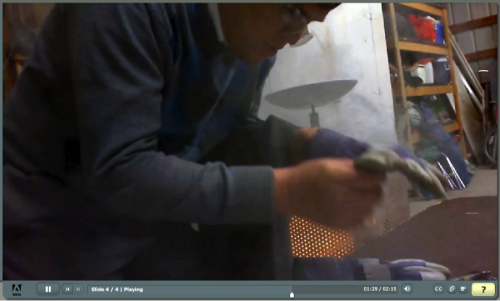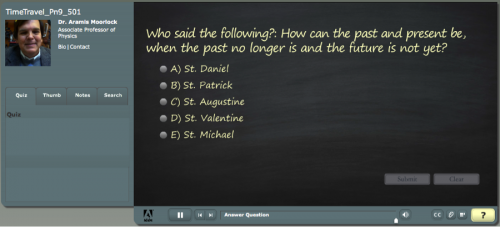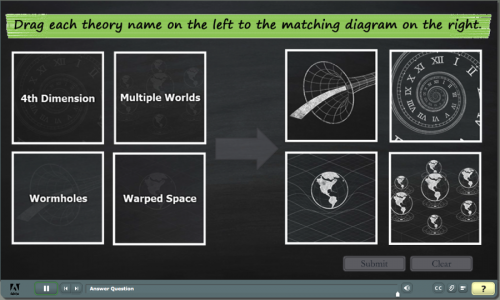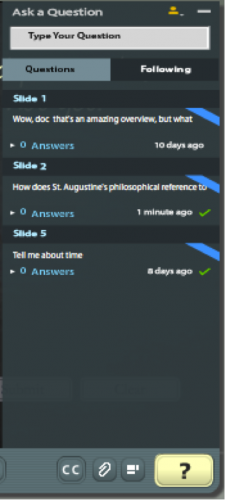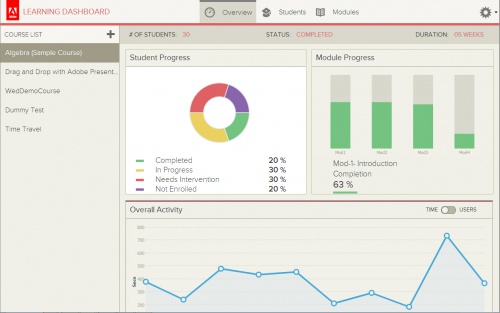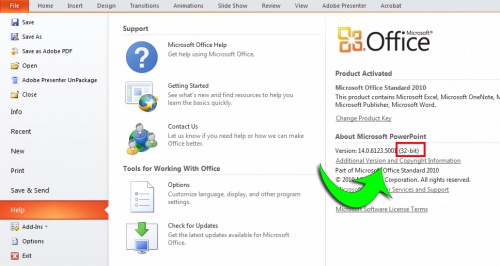 Flipped Classroom (sometimes called flipped teaching) is an approach to education that blends both online instruction and offline learning. Generally in Flipped Classrooms the online learning is done with videos and quizzes offered offline and this gives the teacher more time to spend engaging directly with learners in activities and exercises during class.
Flipped Classroom (sometimes called flipped teaching) is an approach to education that blends both online instruction and offline learning. Generally in Flipped Classrooms the online learning is done with videos and quizzes offered offline and this gives the teacher more time to spend engaging directly with learners in activities and exercises during class.
It earned the name ‘Flipped’ because traditional in class activities (like lecture) are moved to homework time, and traditional homework activities, are moved to the class meeting time. The advantage of this approach is that students are able to ‘practice’ and ‘reflect’ with a teacher close by, so they are more likely to practice collaboration, creative problem solving and effective communication – all skills that are in ever-increasing demand in today’s workplaces.
The advantage of this approach is that students are able to ‘practice’ and ‘reflect’ with a teacher close by, so they are more likely to practice collaboration, creative problem solving and effective communication.
I had the opportunity to speak with Jon Bergmann last week. Jon is a pioneer in flipped classrooms and co-authored the recently published ISTE book on the topic. A seasoned science teacher, Jon travels the world sharing his experiences and advice on flipped classrooms – and is an authentic educator with a passion for promoting learning.
In the above video Jon reminds us all – “It’s not about the technology, it’s about the pedagogy.” The resonant message is that teachers should focus on the advantage they are gaining in creating more time for engagement in class by improving the efficiency of content delivery out of class.
It’s important to remember that there is a bigger picture influencing our thoughts about flipped classrooms. It is a context for ‘how we train and learn.’ For many years we’ve approached education as a didactic delivery system. We promoted the lecture as the default format for delivering ideas, and for the most part assumed that if we pushed information in the general direction of learners, those learners would consume the information. It’s an approach that does work, sometimes – but not most of the time.
 Educational Psychologists have understood for decades that people generally learn better through interactive conversation, engagement and opportunities to explore, practice and reflect – but our educational methods have remained heavily weighted toward information dumping (lectures, books, worksheets) largely because of the ease of these methods and the time it would require to do anything else. It’s also generally controversial for teachers to change the basic approach – and many find that their institutions are so focused on accountability within the traditional approach that changes focused on effective instruction are frowned upon – not because they are ineffective, but because they don’t fit nicely into the reporting and accountability structure.
Educational Psychologists have understood for decades that people generally learn better through interactive conversation, engagement and opportunities to explore, practice and reflect – but our educational methods have remained heavily weighted toward information dumping (lectures, books, worksheets) largely because of the ease of these methods and the time it would require to do anything else. It’s also generally controversial for teachers to change the basic approach – and many find that their institutions are so focused on accountability within the traditional approach that changes focused on effective instruction are frowned upon – not because they are ineffective, but because they don’t fit nicely into the reporting and accountability structure.
I suspect that one reason the flipped classroom is rapidly becoming popular is that two major events are making it increasingly difficult to continue the didactic info-dump approach to education. First, the virtually infinite access to information provided by the Internet changes both how much information is available and provides an obvious example of how most people prefer to learn.
Experiments like Sugatra Mitra’s ‘Hole in the Wall’ demonstrate that people are perfectly capable of constructing their own knowledge – and that they are happy to be active learners, choosing to consume even very complex information out of an instinctive appreciation for learning. The second reason is because new technologies now make it possible to create great online content so quickly and inexpensively that anyone can make online content in about the same amount of time it takes to ‘say it in class.’
Understanding the flipped classroom
Jon Bergmann recently published an excellent summary of 10 questions he recommends that people ask before they flip their classroom.
 Bergmann notes that while resolving the technology questions is important, the most important thing is to consider how you will use the extra time that you create. The advantage of flipping the classroom after all comes from the time gained to work more directly with the students. Hearing students discuss ideas, solve problems and collaborate on a given topic can give the teacher significant insight into how well each student is mastering material, and can ensure that all of the students master the material more completely.
Bergmann notes that while resolving the technology questions is important, the most important thing is to consider how you will use the extra time that you create. The advantage of flipping the classroom after all comes from the time gained to work more directly with the students. Hearing students discuss ideas, solve problems and collaborate on a given topic can give the teacher significant insight into how well each student is mastering material, and can ensure that all of the students master the material more completely.
Bergmann also highlights the importance of communicating. Communicating with parents, administrators, students and colleagues – both what you expect from yourself and from the other parties involved. I suspect that this sage advice is rooted in helping others to understand the rationale.
On a related note, Jon Bergmann will be doing an eSeminar about Flipping the Classroom on at 10:00 AM US Pacific time on Thursday, September 12, 2013 entitled “Ten Questions You Should Ask Before Flipping Your Classroom.” Adobe is proud to sponsor Mr. Bergmann’s online session as part of our effort to contribute to the online learning community. You can register to participate in the free session here: http://www.adobe.com/cfusion/event/index.cfm?event=detail&id=2286678&loc=en_us
 Of course the technology is also a key factor in creating flipped classrooms. Both –what technology you will use to create content, and what you expect of that content. For example, do you want to be able to instantly create videos? Do you want to be able to show both live videos and capture elements from your computer screen? Do you want to be able to integrate quizzes or use other solutions to know that your learners; a.) Watched the online content and b.) Understood the online content?
Of course the technology is also a key factor in creating flipped classrooms. Both –what technology you will use to create content, and what you expect of that content. For example, do you want to be able to instantly create videos? Do you want to be able to show both live videos and capture elements from your computer screen? Do you want to be able to integrate quizzes or use other solutions to know that your learners; a.) Watched the online content and b.) Understood the online content?
Adobe has been focused on providing an ideal ‘all in one’ tool for flipped classrooms to ease the process of creating flipped classroom content that let’s teachers keep track of student viewing habits, and even makes it possible for students and teachers to have conversations about the course content.
Let’s look at some examples
Sarah Gilbert is well known for her presentations on mobile Learning and eLearning. Her eLearning company, meLearning Solutions has been rapidly adopting Flipped classrooms for Corporate training. That’s right, even though Flipped classrooms started as a largely K-12 online learning initiative, companies are rapidly finding that the same advantages apply to training courses delivered to employees. Here’s Sarah doing a short video, explaining how meLearning uses Adobe Presenter Video Creator to make the videos for their Flipped Classroom Training.
Education leaders in the press are starting to see a clear pattern as well. Jason Tomaszewski of Education World says that Adobe Presenter “…could work wonders in a flipped classroom.” Tomaszewski also calls Adobe Presenter “perfect not only for bringing absent students up to speed on missed lessons, but also for preparing substitute teachers.” (Education World, Tech in the Classroom, August 5, 2013.)
Working with eLearning Brothers, Adobe created the following simple example of the online portion of a flipped classroom. (Remember, putting your lectures online as interactive, collaborative assignments with quizzes is just one part of flipping the classroom. All the time you gain in class opens the door for your to do amazing activities and work in small groups and 1:1 with your students during the regular class meetings.)
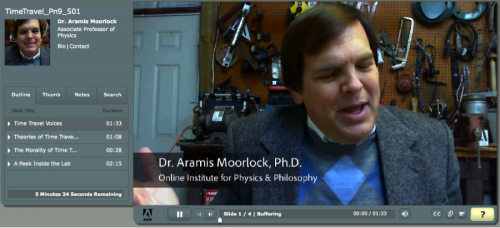
Or Download the Source Presenter 9 Package file if you’d like to see how the project was created. (Note that you may use the source project as a reference file to better understand how to build your course, but the images and videos in the downloaded file may not be used for your own projects.)
The Adobe example gives you a tangible way to understand how you can quickly and easily create the online component – so that your time can be concentrated much more on the work you do in class with the students.
You can think of the online content as follows;
Video of you doing a short lesson (featuring both you, and whatever is on your computer screen.) An optional quiz after the video(s) The option to enable and track both discussions & quiz questions
Adobe Presenter 9 let’s you easily create content that does all of these things, right inside the published online content. In fact it’s really the only all-in-one solution for the technology side of flipping the classroom. It’s also the easiest to use. In fact it’s so smooth, so easy to use, and so powerful that it won the CODiE award for Best Video Tool of 2013.
A deeper look at the power of video
Breaking down those elements, you can see each in the Time Travel example. First, a video is created featuring both the eccentric Professor Moorlock, and his PowerPoint slides about Time Travel. Dr. Moorlock’s lessons are broken into four parts and a video is given for each of those four parts.
In a typical class we often lecture for an hour or longer on a given topic. But anyone who has taught will tell you that during that time, we are repeating ourselves at least three times. This is because the minds of our learners wander while we are speaking. (There’s a lot of research that explains how and why minds wander during lectures, but suffice it to say, that because we know they do, we repeat things.)
In general, only 1/3 of that material that we include is actually necessary for the lesson. In addition to that, we usually will cover a topic in 3 or 4 parts. So 60 minutes is really 20 minutes of content, explained 3 times in different ways, and 20 minutes of content is usually actually 3 or 4, 5-7 minute short topics / subtopics. Once you realize that you can cover most lessons with 3 or 4 five minute videos (that can be replayed, rather than restated) you start to realize that even creating your videos can be a fairly simple task.
There are several bonus benefits here. 1. You can often reuse the videos for more than one class, section, year – etc. So after the initial effort, you only need to create occasional videos to add new information or correct information that has changed. 2. Research suggests that students do better with 5 minute chunks than they do with 60 minute lectures anyway. 3. If you decide later that you want to change or add something – it’s easy to replace or supplant a small element.
While the example uses only video of the eccentric professor and PowerPoint slides, instructors can actually show anything that is on their computer. You can show videos, other applications – really anything that you’ve placed on your computer. This introduces the possibility to include things like photos from class or from a field activity, interactive 3D simulations, overviews demonstrating math or engineering concepts – anything that you can show on your computer. It is a very powerful expansion of your classroom communication resources.
It also gives you an easy solution for archiving and reusing guest lectures & even online video lessons from visiting experts. You can easily record the guest lesson and then provide it in subsequent courses as a resource to students who take the course long after the guest has visited.
Video also provides you with a tool for documenting lab activities, showing experiments, and even interviewing multiple parties. Any science teacher or lab supervisor can verify that much of our time in such classes is spent repeating the same information over and over for each student, when a video of a demonstration can give every learner a front row seat to see and better understand the exercise or activity.
You can even use the video to bring interest to a traditional visual aid, holding up a chart, an illustration, an artifact, or a computing tool like an iPad to the camera to help others see you manipulating information or ideas in the same manner that they will be asked to.
The role of quizzes in the online content for Flipped Classrooms
It certainly isn’t news to any trainer or teacher that students are good at neglecting their homework. Whether due to distraction, procrastination or simple laziness, students often don’t do the assignments their given to do outside of class. So the obvious first question when flipping a classroom is; But how do I know they’ve actually watched the lectures?
The short answer is that you can provide simple quizzes to help ensure that the students are both watching the videos and are understanding the core concepts that are explained in the videos.
In addition to the usual True/False, Multiple Choice, and Fill in the Blank Questions, you can easily use Adobe Presenter to create Drag and Drop, Matching, Short Answer, Sequencing and Hot Spot questions. It gives you plenty of freedom to ask questions however you feel is most appropriate for your course.
In addition to asking questions, you’ll also want to know if the students actually viewed the videos and you might even want to know if they watched all or part of a given video more than one time. Fortunately online content can easily be tracked to determine whether your students have accessed and used their homework. Unfortunately most methods of tracking that kind of access are awkward and require a lot of extra effort for teachers.
Adobe Presenter actually provides several very simple ways to both encourage student engagement with the online content, and to easily learn how much time and effort each student has spent working with the videos and quizzes. It also makes quiz creation simple, and tracking the learner’s quiz results simple.
Thanks to the new Learning Intervention tools in Adobe Presenter, teachers can even use the tools to quickly identify students who are not performing as well as expected, or who are not using the online course content as much as expected, and instantly send messages to individuals or the entire group of at risk students to let them know that you expect more, and advise them about ways they can do better.
It’s kind of like having a helper who sees everything that the learners do, and then tells you – “Hey, this group isn’t doing well on the last online assignment. Would you like to send them a note to remind them before class so they don’t fall behind?”
Adobe Presenter 9 also let’s you convert your online videos and quizzes into a collaborative environment for students to discuss, ask and answer questions. Just check the option to enable course collaboration and your learners are automatically able to post comments and questions, answer questions, and even follow and like one another’s contributions.
Once you’ve enabled collaboration for a given lesson, you and your students are able to post comments and questions. You can also use the Learner Intervention tool to track the student’s conversations / contributions and assess their engagement. Adobe even provides a metric called the participation index, that allows you to easily compare all of the students’ discussion and evaluate how well they are participating. If you want, you can include the participation index in the overall course grading – so you can identify students who don’t discuss as easily as you identified students who are performing poorly on quizzes.
Now such examples are all the more useful if you can see them in the authoring tool. So I’m sharing the source content here so you can download and experiment – replicate to your heart’s content, but do not use the images or videos contained in the source file for other purposes.
Adobe Presenter 9 was used to make this example. You’ll need Adobe Presenter 9 in order to view the source of the example. Adobe Presenter 9 installs as a plug-in right inside your copy of Microsoft PowerPoint. It adds several new abilities to PowerPoint, including the ability to make show-and-tell videos. Such videos are a perfect hub for creating the online component of your video classroom.
You can download a free trial of Adobe Presenter 9 here. Keep in mind the following. This tool is only available for Windows, so you’ll need either a Windows computer or a Mac running Parallels or running Windows in BootCamp.
Presenter is a PowerPoint plugin, so the version of Presenter that you use, will need to match the Bit depth of your version of Microsoft Office (not necessarily the same as your version of Windows.) Most people today run Windows 64 bit computers, but the vast majority of people still use 32 bit Office. You need to match your Office version, not your operating system. Here’s a quick way to figure out which version of Office you are running.
To find your version of Office, click on the File Menu in ANY Office application, then choose Help. (Note this only applies to Windows.) You’ll get the above image. Look under the About Microsoft Word section.
You’ll see the bit depth in parenthesis on the right. If it says 32-bit, download and install the 32 bit version of Presenter. If it says 64-bit, download and install the 64 bit version of Presenter.
One last consideration; if you have Office 2007, 2010 or 2013 you should be able to use Adobe Presenter 9. If however you have Office 2013 in the 64 bit variety, the Presenter 9 plugin is not yet available. You’ll have to wait a short while until the 64 bit flavor is released for Office 2013. (It shouldn’t be too long, so you might want to check just to be sure to see if the new 64 bit version has been added, depending on when you read this article.)
 Flipped Classroom (sometimes called flipped teaching) is an approach to education that blends both online instruction and offline learning. Generally in Flipped Classrooms the online learning is done with videos and quizzes offered offline and this gives the teacher more time to spend engaging directly with learners in activities and exercises during class.
Flipped Classroom (sometimes called flipped teaching) is an approach to education that blends both online instruction and offline learning. Generally in Flipped Classrooms the online learning is done with videos and quizzes offered offline and this gives the teacher more time to spend engaging directly with learners in activities and exercises during class.
It earned the name ‘Flipped’ because traditional in class activities (like lecture) are moved to homework time, and traditional homework activities, are moved to the class meeting time. The advantage of this approach is that students are able to ‘practice’ and ‘reflect’ with a teacher close by, so they are more likely to practice collaboration, creative problem solving and effective communication – all skills that are in ever-increasing demand in today’s workplaces.
The advantage of this approach is that students are able to ‘practice’ and ‘reflect’ with a teacher close by, so they are more likely to practice collaboration, creative problem solving and effective communication.
I had the opportunity to speak with Jon Bergmann last week. Jon is a pioneer in flipped classrooms and co-authored the recently published ISTE book on the topic. A seasoned science teacher, Jon travels the world sharing his experiences and advice on flipped classrooms – and is an authentic educator with a passion for promoting learning.
In the above video Jon reminds us all – “It’s not about the technology, it’s about the pedagogy.” The resonant message is that teachers should focus on the advantage they are gaining in creating more time for engagement in class by improving the efficiency of content delivery out of class.
It’s important to remember that there is a bigger picture influencing our thoughts about flipped classrooms. It is a context for ‘how we train and learn.’ For many years we’ve approached education as a didactic delivery system. We promoted the lecture as the default format for delivering ideas, and for the most part assumed that if we pushed information in the general direction of learners, those learners would consume the information. It’s an approach that does work, sometimes – but not most of the time.
 Educational Psychologists have understood for decades that people generally learn better through interactive conversation, engagement and opportunities to explore, practice and reflect – but our educational methods have remained heavily weighted toward information dumping (lectures, books, worksheets) largely because of the ease of these methods and the time it would require to do anything else. It’s also generally controversial for teachers to change the basic approach – and many find that their institutions are so focused on accountability within the traditional approach that changes focused on effective instruction are frowned upon – not because they are ineffective, but because they don’t fit nicely into the reporting and accountability structure.
Educational Psychologists have understood for decades that people generally learn better through interactive conversation, engagement and opportunities to explore, practice and reflect – but our educational methods have remained heavily weighted toward information dumping (lectures, books, worksheets) largely because of the ease of these methods and the time it would require to do anything else. It’s also generally controversial for teachers to change the basic approach – and many find that their institutions are so focused on accountability within the traditional approach that changes focused on effective instruction are frowned upon – not because they are ineffective, but because they don’t fit nicely into the reporting and accountability structure.
I suspect that one reason the flipped classroom is rapidly becoming popular is that two major events are making it increasingly difficult to continue the didactic info-dump approach to education. First, the virtually infinite access to information provided by the Internet changes both how much information is available and provides an obvious example of how most people prefer to learn.
Experiments like Sugatra Mitra’s ‘Hole in the Wall’ demonstrate that people are perfectly capable of constructing their own knowledge – and that they are happy to be active learners, choosing to consume even very complex information out of an instinctive appreciation for learning. The second reason is because new technologies now make it possible to create great online content so quickly and inexpensively that anyone can make online content in about the same amount of time it takes to ‘say it in class.’
Understanding the flipped classroom
Jon Bergmann recently published an excellent summary of 10 questions he recommends that people ask before they flip their classroom.
 Bergmann notes that while resolving the technology questions is important, the most important thing is to consider how you will use the extra time that you create. The advantage of flipping the classroom after all comes from the time gained to work more directly with the students. Hearing students discuss ideas, solve problems and collaborate on a given topic can give the teacher significant insight into how well each student is mastering material, and can ensure that all of the students master the material more completely.
Bergmann notes that while resolving the technology questions is important, the most important thing is to consider how you will use the extra time that you create. The advantage of flipping the classroom after all comes from the time gained to work more directly with the students. Hearing students discuss ideas, solve problems and collaborate on a given topic can give the teacher significant insight into how well each student is mastering material, and can ensure that all of the students master the material more completely.
Bergmann also highlights the importance of communicating. Communicating with parents, administrators, students and colleagues – both what you expect from yourself and from the other parties involved. I suspect that this sage advice is rooted in helping others to understand the rationale.
On a related note, Jon Bergmann will be doing an eSeminar about Flipping the Classroom on at 10:00 AM US Pacific time on Thursday, September 12, 2013 entitled “Ten Questions You Should Ask Before Flipping Your Classroom.” Adobe is proud to sponsor Mr. Bergmann’s online session as part of our effort to contribute to the online learning community. You can register to participate in the free session here: http://www.adobe.com/cfusion/event/index.cfm?event=detail&id=2286678&loc=en_us
 Of course the technology is also a key factor in creating flipped classrooms. Both –what technology you will use to create content, and what you expect of that content. For example, do you want to be able to instantly create videos? Do you want to be able to show both live videos and capture elements from your computer screen? Do you want to be able to integrate quizzes or use other solutions to know that your learners; a.) Watched the online content and b.) Understood the online content?
Of course the technology is also a key factor in creating flipped classrooms. Both –what technology you will use to create content, and what you expect of that content. For example, do you want to be able to instantly create videos? Do you want to be able to show both live videos and capture elements from your computer screen? Do you want to be able to integrate quizzes or use other solutions to know that your learners; a.) Watched the online content and b.) Understood the online content?
Adobe has been focused on providing an ideal ‘all in one’ tool for flipped classrooms to ease the process of creating flipped classroom content that let’s teachers keep track of student viewing habits, and even makes it possible for students and teachers to have conversations about the course content.
Let’s look at some examples
Sarah Gilbert is well known for her presentations on mobile Learning and eLearning. Her eLearning company, meLearning Solutions has been rapidly adopting Flipped classrooms for Corporate training. That’s right, even though Flipped classrooms started as a largely K-12 online learning initiative, companies are rapidly finding that the same advantages apply to training courses delivered to employees. Here’s Sarah doing a short video, explaining how meLearning uses Adobe Presenter Video Creator to make the videos for their Flipped Classroom Training.
Education leaders in the press are starting to see a clear pattern as well. Jason Tomaszewski of Education World says that Adobe Presenter “…could work wonders in a flipped classroom.” Tomaszewski also calls Adobe Presenter “perfect not only for bringing absent students up to speed on missed lessons, but also for preparing substitute teachers.” (Education World, Tech in the Classroom, August 5, 2013.)
Working with eLearning Brothers, Adobe created the following simple example of the online portion of a flipped classroom. (Remember, putting your lectures online as interactive, collaborative assignments with quizzes is just one part of flipping the classroom. All the time you gain in class opens the door for your to do amazing activities and work in small groups and 1:1 with your students during the regular class meetings.)

Or Download the Source Presenter 9 Package file if you’d like to see how the project was created. (Note that you may use the source project as a reference file to better understand how to build your course, but the images and videos in the downloaded file may not be used for your own projects.)
The Adobe example gives you a tangible way to understand how you can quickly and easily create the online component – so that your time can be concentrated much more on the work you do in class with the students.
You can think of the online content as follows;
Video of you doing a short lesson (featuring both you, and whatever is on your computer screen.) An optional quiz after the video(s) The option to enable and track both discussions & quiz questions
Adobe Presenter 9 let’s you easily create content that does all of these things, right inside the published online content. In fact it’s really the only all-in-one solution for the technology side of flipping the classroom. It’s also the easiest to use. In fact it’s so smooth, so easy to use, and so powerful that it won the CODiE award for Best Video Tool of 2013.
A deeper look at the power of video
Breaking down those elements, you can see each in the Time Travel example. First, a video is created featuring both the eccentric Professor Moorlock, and his PowerPoint slides about Time Travel. Dr. Moorlock’s lessons are broken into four parts and a video is given for each of those four parts.
In a typical class we often lecture for an hour or longer on a given topic. But anyone who has taught will tell you that during that time, we are repeating ourselves at least three times. This is because the minds of our learners wander while we are speaking. (There’s a lot of research that explains how and why minds wander during lectures, but suffice it to say, that because we know they do, we repeat things.)
In general, only 1/3 of that material that we include is actually necessary for the lesson. In addition to that, we usually will cover a topic in 3 or 4 parts. So 60 minutes is really 20 minutes of content, explained 3 times in different ways, and 20 minutes of content is usually actually 3 or 4, 5-7 minute short topics / subtopics. Once you realize that you can cover most lessons with 3 or 4 five minute videos (that can be replayed, rather than restated) you start to realize that even creating your videos can be a fairly simple task.
There are several bonus benefits here. 1. You can often reuse the videos for more than one class, section, year – etc. So after the initial effort, you only need to create occasional videos to add new information or correct information that has changed. 2. Research suggests that students do better with 5 minute chunks than they do with 60 minute lectures anyway. 3. If you decide later that you want to change or add something – it’s easy to replace or supplant a small element.
While the example uses only video of the eccentric professor and PowerPoint slides, instructors can actually show anything that is on their computer. You can show videos, other applications – really anything that you’ve placed on your computer. This introduces the possibility to include things like photos from class or from a field activity, interactive 3D simulations, overviews demonstrating math or engineering concepts – anything that you can show on your computer. It is a very powerful expansion of your classroom communication resources.
It also gives you an easy solution for archiving and reusing guest lectures & even online video lessons from visiting experts. You can easily record the guest lesson and then provide it in subsequent courses as a resource to students who take the course long after the guest has visited.
Video also provides you with a tool for documenting lab activities, showing experiments, and even interviewing multiple parties. Any science teacher or lab supervisor can verify that much of our time in such classes is spent repeating the same information over and over for each student, when a video of a demonstration can give every learner a front row seat to see and better understand the exercise or activity.
You can even use the video to bring interest to a traditional visual aid, holding up a chart, an illustration, an artifact, or a computing tool like an iPad to the camera to help others see you manipulating information or ideas in the same manner that they will be asked to.
The role of quizzes in the online content for Flipped Classrooms
It certainly isn’t news to any trainer or teacher that students are good at neglecting their homework. Whether due to distraction, procrastination or simple laziness, students often don’t do the assignments their given to do outside of class. So the obvious first question when flipping a classroom is; But how do I know they’ve actually watched the lectures?
The short answer is that you can provide simple quizzes to help ensure that the students are both watching the videos and are understanding the core concepts that are explained in the videos.
In addition to the usual True/False, Multiple Choice, and Fill in the Blank Questions, you can easily use Adobe Presenter to create Drag and Drop, Matching, Short Answer, Sequencing and Hot Spot questions. It gives you plenty of freedom to ask questions however you feel is most appropriate for your course.
In addition to asking questions, you’ll also want to know if the students actually viewed the videos and you might even want to know if they watched all or part of a given video more than one time. Fortunately online content can easily be tracked to determine whether your students have accessed and used their homework. Unfortunately most methods of tracking that kind of access are awkward and require a lot of extra effort for teachers.
Adobe Presenter actually provides several very simple ways to both encourage student engagement with the online content, and to easily learn how much time and effort each student has spent working with the videos and quizzes. It also makes quiz creation simple, and tracking the learner’s quiz results simple.
Thanks to the new Learning Intervention tools in Adobe Presenter, teachers can even use the tools to quickly identify students who are not performing as well as expected, or who are not using the online course content as much as expected, and instantly send messages to individuals or the entire group of at risk students to let them know that you expect more, and advise them about ways they can do better.
It’s kind of like having a helper who sees everything that the learners do, and then tells you – “Hey, this group isn’t doing well on the last online assignment. Would you like to send them a note to remind them before class so they don’t fall behind?”
Adobe Presenter 9 also let’s you convert your online videos and quizzes into a collaborative environment for students to discuss, ask and answer questions. Just check the option to enable course collaboration and your learners are automatically able to post comments and questions, answer questions, and even follow and like one another’s contributions.
Once you’ve enabled collaboration for a given lesson, you and your students are able to post comments and questions. You can also use the Learner Intervention tool to track the student’s conversations / contributions and assess their engagement. Adobe even provides a metric called the participation index, that allows you to easily compare all of the students’ discussion and evaluate how well they are participating. If you want, you can include the participation index in the overall course grading – so you can identify students who don’t discuss as easily as you identified students who are performing poorly on quizzes.
Now such examples are all the more useful if you can see them in the authoring tool. So I’m sharing the source content here so you can download and experiment – replicate to your heart’s content, but do not use the images or videos contained in the source file for other purposes.
Adobe Presenter 9 was used to make this example. You’ll need Adobe Presenter 9 in order to view the source of the example. Adobe Presenter 9 installs as a plug-in right inside your copy of Microsoft PowerPoint. It adds several new abilities to PowerPoint, including the ability to make show-and-tell videos. Such videos are a perfect hub for creating the online component of your video classroom.
You can download a free trial of Adobe Presenter 9 here. Keep in mind the following. This tool is only available for Windows, so you’ll need either a Windows computer or a Mac running Parallels or running Windows in BootCamp.
Presenter is a PowerPoint plugin, so the version of Presenter that you use, will need to match the Bit depth of your version of Microsoft Office (not necessarily the same as your version of Windows.) Most people today run Windows 64 bit computers, but the vast majority of people still use 32 bit Office. You need to match your Office version, not your operating system. Here’s a quick way to figure out which version of Office you are running.
To find your version of Office, click on the File Menu in ANY Office application, then choose Help. (Note this only applies to Windows.) You’ll get the above image. Look under the About Microsoft Word section.
You’ll see the bit depth in parenthesis on the right. If it says 32-bit, download and install the 32 bit version of Presenter. If it says 64-bit, download and install the 64 bit version of Presenter.
One last consideration; if you have Office 2007, 2010 or 2013 you should be able to use Adobe Presenter 9. If however you have Office 2013 in the 64 bit variety, the Presenter 9 plugin is not yet available. You’ll have to wait a short while until the 64 bit flavor is released for Office 2013. (It shouldn’t be too long, so you might want to check just to be sure to see if the new 64 bit version has been added, depending on when you read this article.)
You must be logged in to post a comment.
- Most Recent
- Most Relevant
this is an interesting resource for implementing flipped classroom in a jiffy!
i would like to talk to you about the possibility of working together. I represent an organization called SPEED and my work in the past year has been studying flipped classroom for engineering education and the results were interestingly positive. I would like to talk more about this. my email aswinkarthik.rv@worldspeed.org
[…] Fuente / Source: “https://elearning.adobe.com/2013/08/what-is-a-flipped-classroom-and-how-can-it-help-me.… […]



